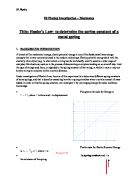Title: Hooke’s Law
Aim: To determine the spring constant.
Equipment:
- Retort stand (with clamp)
- Spring (with hook)
- Masses ( 100g, 200g, 300g, 400g, 500g )
- Ruler
Variables:
Independent Variable:
- Changing the mass ჻ Weight force (F).
Dependent Variable:
- The extension of the spring Δx.
Control Variable:
- “Spring” → Dimensions of the spring.
→ Mass of the spring.
→ Radius of the spring.
- “Retort Stand” → Height of the retort stand.
Method:
- The spring (its dimensions, mass and its radius) were measured in its initial face.
- The spring was then place in the clamps of the retort stand and was held together tightly enough to hold it in place.
- At the end of the spring (where the hook is), a mass of 100 grams was placed and as a result the spring started to extend downwards.
- Its extension after the weight was placed on the hook was measured using a ruler and compared to its initial face.
- After five continuous trials with the same mass (100 g) a mass of 200 grams was placed on the hook. Five trials were performed for all 100,200,300,400 and 500 grams respectively, following the same procedure stated before.
- The results were observed and copied in a notebook, were a table was made showing the masses, and the (cm) results of the extensions for each trial.







